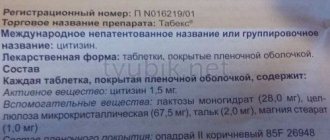Instructions for use PARLAZIN® tab
Suction
After taking the drug orally, cetirizine is rapidly absorbed from the gastrointestinal tract.
The equilibrium maximum concentration is approximately 300 ng/ml and is achieved within 1.0 ± 0.5 hours. The equilibrium state is achieved on the third day. In volunteers, pharmacokinetic parameters (Cmax and AUC) and distribution are unimodal.
Food does not affect the completeness of absorption, although the rate of absorption decreases. The degree of bioavailability is similar when cetirizine is used in the form of solution, capsules or tablets.
Distribution
In adults, after taking 10 mg of the drug orally, the apparent volume of distribution is approximately 35 l (0.50 l/kg). 93 ± 0.3% of cetirizine is protein bound. Cetirizine does not affect the binding of warfarin to plasma proteins.
Cetirizine is excreted in small quantities in breast milk.
Biotransformation
Cetirizine does not undergo significant pre-systemic metabolism.
Removal
About 2/3 of the dose is excreted unchanged in the urine. The terminal half-life is approximately 10 hours and cetirizine did not accumulate when administered repeatedly for 10 days at a dose of 10 mg/day.
Linearity/nonlinearity
Cetirizine has linear kinetics in the dose range from 5 to 60 mg.
Special patient groups
Elderly
In 16 elderly volunteer subjects, after a single oral dose of cetirizine 10 mg, the elimination half-life was increased by approximately 50% and clearance was reduced by 40%, compared with younger individuals. The decreased clearance of cetirizine in these elderly volunteers was likely due to worsening renal function.
Children and adolescents under 18 years of age
The half-life of cetirizine was approximately 6 hours in children aged 6 to 12 years and 5 hours in children aged 2 to 6 years. In small children and infants aged 6 to 24 months, the half-life is reduced to 3.1 hours.
Patients with impaired renal function
In patients with mild renal failure (creatinine clearance > 40 ml/min), the pharmacokinetics of the drug were similar to those in healthy volunteers. With moderate renal failure (creatinine clearance 10-40 ml/min), compared with healthy volunteers, the half-life increases three times, and clearance decreases by 70%.
Compared with healthy volunteers, in patients on hemodialysis (CrCl <7 ml/min) after a single dose of cetirizine 10 mg, the half-life increased threefold and clearance decreased by 70%. Cetirizine is poorly removed by hemodialysis (<10%). In case of moderate to severe impairment of renal function, a dose adjustment of cetirizine is necessary (see Dosage Regimen).
Patients with liver dysfunction
In patients with chronic liver dysfunction (hepatocellular, cholestatic or biliary cirrhosis), after oral administration of 10 mg or 20 mg cetirizine, the half-life decreased by 50% and clearance decreased by 40%.
Dose changes are only necessary in patients with concurrent impairment of liver and kidney function.
Parlazin Neo tablets p/o 5 mg No. 7x2
Name
Parlazin Neo tab. p/o 5 mg per bl. in pack No. 7x2
Description
White or almost white, round, moderately biconvex, film-coated tablets, odorless or almost odorless. Engraving: on one side of the tablet there is a stylized letter E, on the other side there is the number 281.
Main active ingredient
Levocetirizine dihydrochloride
Release form
7 or 10 coated tablets in a blister made of a combined “cold” film (polyamide/aluminum foil/PVC)/aluminum foil. 1, 2 or 3 blisters of 10 tablets, 1 or 2 blisters of 7 tablets are placed in a cardboard box with instructions for use for patients.
Dosage
5 mg per bl. in pack No. 7x2
Indications for use
In adults and children over 6 years of age, Parlazin® Neo is used to treat the following diseases: - allergic rhinitis (runny nose), hay fever - allergic conjunctivitis - chronic urticaria (often accompanied by itching) For children aged 2-6 years, Parlazin Neo should be prescribed in droplet form, since in this age group tablets do not provide a safe dosage regimen.
Directions for use and doses
Always take this drug as directed by these instructions or as directed by your doctor. If you are unsure, you should consult your doctor. The duration of treatment is determined by the doctor and depends on the type, duration and dynamics of the patient’s complaints. Dosage regimen Adults, adolescents and children over 6 years of age The daily recommended dose is 1 tablet once a day (1–5 mg). In patients with impaired renal function, reduced doses may be prescribed depending on the severity of renal damage. The dosage regimen must be determined by your doctor. When prescribing the drug to patients with impaired liver function, no dose changes are required. Directions for use The tablets should be swallowed whole, without chewing, and washed down with liquid; they can be taken with or without food. If you have taken too much Parlazin® Neo tablets If you think you have taken an excessive dose of Parlazin® Neo tablets, tell your doctor, who will decide what action is necessary. If you forget to take Parlazin® Neo tablets Do not take a double dose to make up for the missed dose. Just wait until it is time for your next dose and take the regular dose prescribed by your doctor. If you stop taking Parlazin® Neo tablets prematurely Stopping taking Parlazin® Neo tablets earlier than prescribed should not cause harm in the sense that the symptoms of the disease will only gradually return, without becoming more severe than before taking Parlazin® Neo. Do not change the recommended dose. Contact your doctor or pharmacist if you think the effect of the medicine is too weak or strong. If you have any further questions about using this drug, ask your doctor or pharmacist.
Use during pregnancy and lactation
If you are pregnant, breastfeeding, think you may be pregnant, or are planning to have a baby, tell your doctor. Pregnancy Despite the fact that animal experiments have not revealed the harmful effects of levocetirizine, Parlazin® Neo tablets - like other drugs - are not recommended for use during pregnancy. If you accidentally take Parlazin® Neo tablets during pregnancy, this medicine will not have any adverse effects on the fetus, but you should stop taking the tablets. Breastfeeding During breastfeeding, Parlazin Neo tablets should not be taken, as it is expected that the active substance may pass into breast milk. Before taking any medications, consult your doctor.
Precautionary measures
Talk to your doctor or pharmacist before taking Parlazin® Neo tablets. Be sure to tell your doctor the following information: - if you have a tendency to retain urine (inability to empty your bladder completely), for example due to a spinal cord injury or an enlarged prostate gland; — Parlazin® Neo tablets contain lactose; - if you suffer from other diseases, allergies or use any other medications (for internal or external use), including those sold without a prescription. Children and adolescents under 18 years of age Parlazin® Neo should not be prescribed to infants and children under 2 years of age due to insufficient data on its use. For the safe treatment of children aged 2-6 years, it is recommended to use the drug Parlazin® Neo in the form of drops for oral administration, since the required dose cannot be selected using tablets. The drug Parlazin® Neo tablets contain milk sugar (lactose) as an excipient. The drug Parlazin Neo tablets contain lactose, so if your doctor has told you that you are intolerant to certain sugars, contact him for advice before using this medicine.
Interaction with other drugs
Tell your doctor about any medications you are taking, have recently taken, or plan to take, including those taken without a prescription. Antihistamines can mask skin reactions during allergy skin tests, so Parlazin® Neo should be discontinued at least 3 days before such a test. Taking with food, drinks and alcohol The drug can be taken regardless of meals. Avoid drinking alcohol while taking this drug as concomitant use of levocetirizine and alcohol may have effects on the nervous system in sensitive patients.
Contraindications
- if you are allergic to the active substance, other substances similar in structure, or any of the excipients of the drug listed in the “Composition” section; - if you have severe renal impairment (creatinine clearance
Compound
Active ingredient: 5 mg of levocetirizine dihydrochloride (corresponding to 4.21 mg of levocetirizine) in each coated tablet. Excipients: Core: microcrystalline silica cellulose (composition: microcrystalline cellulose, anhydrous colloidal silicon dioxide), lactose monohydrate (37.9 mg), low-substituted hydroxypropylcellulose (L-HPC-11), magnesium stearate. Shell: Opadry II 33G28523 white (composition: hypromellose 2910, titanium dioxide (E-171), lactose monohydrate (1.05 mg), macrogol 3350, triacetylglycerol).
Side effect
Like all medicines, Parlazin® Neo tablets can cause side effects, although not all patients get them. Fatigue, drowsiness, dry mouth, headache, and weakness have been reported. In some cases, allergic reactions were observed (swelling of the lips, tongue, eyelids, itching, inflammatory skin rash), photosensitivity of the skin, skin cracks, swelling, sinus thrombosis, jugular vein thrombosis, paresthesia (changes in skin sensitivity, for example, a feeling of tingling or ants crawling on skin), hypotrichosis (hair loss), gastrointestinal disorders, abdominal pain, palpitations, rapid pulse, angina, cramps, eye inflammation, blurred vision, blurred vision, muscle pain, aggression or restlessness, insomnia, thoughts of suicide, hallucinations, depression, increased runny nose, respiratory failure, liver inflammation, liver dysfunction (changes in laboratory test results), increased appetite, vomiting, dizziness, trembling, loss of consciousness, impaired taste, weight gain, sudden urge to urinate, urinary retention - inability to completely empty the bladder, ineffectiveness of the drug, dry mucous membranes. If you experience any of the side effects listed above, contact your healthcare provider, who will assess the severity of your symptoms and decide what action is necessary. Reporting side effects If you notice any of these side effects or if you experience any effects not listed in this leaflet, please contact your doctor or pharmacist. By reporting side effects, you will be providing additional information about the safety of this drug.
Storage conditions
Store at a temperature not exceeding 30°C, out of the reach of children!
Release form
Drops for oral administration, 10 mg/ml.
20 ml of the drug in a brown glass bottle with a PE dropper and a polypropylene cap with an inner PE layer, with first-opening control, as well as protection against opening by children. 1 bottle is packed in a cardboard box.
Film-coated tablets, 10 mg.
5, 7 or 10 tablets each. in blisters made of PVC/PVDC/aluminum foil. 1 blister (5, 7 or 10 tablets each) or 3 blisters (10 tablets each) are packed in a cardboard box.
Dosage form and composition
| Drops for oral administration | 1 ml |
| active substance: | |
| cetirizine dihydrochloride | 10 mg |
| excipients: glycerol - 250 mg; propylene glycol - 350 mg; sodium saccharinate - 10 mg; sodium acetate trihydrate - 10 mg; methyl parahydroxybenzoate - 1.35 mg; propyl parahydroxybenzoate - 0.15 mg; glacial acetic acid - 0.5 mg; purified water - up to 1 ml |
| Film-coated tablets | 1 table |
| active substance: | |
| cetirizine dihydrochloride | 10 mg |
| excipients: colloidal anhydrous silicon dioxide - 0.8 mg; magnesium stearate - 1.7 mg; lactose monohydrate - 11.5 mg; MCC - 91 mg | |
| shell: Opadry Y-1-7000 (hypromellose; titanium dioxide CI 77891, macrogol 400) - 4 mg; Ariavit "Sunset" yellow CI 15985 (dye "Sunset" yellow) - 0.01 mg |



